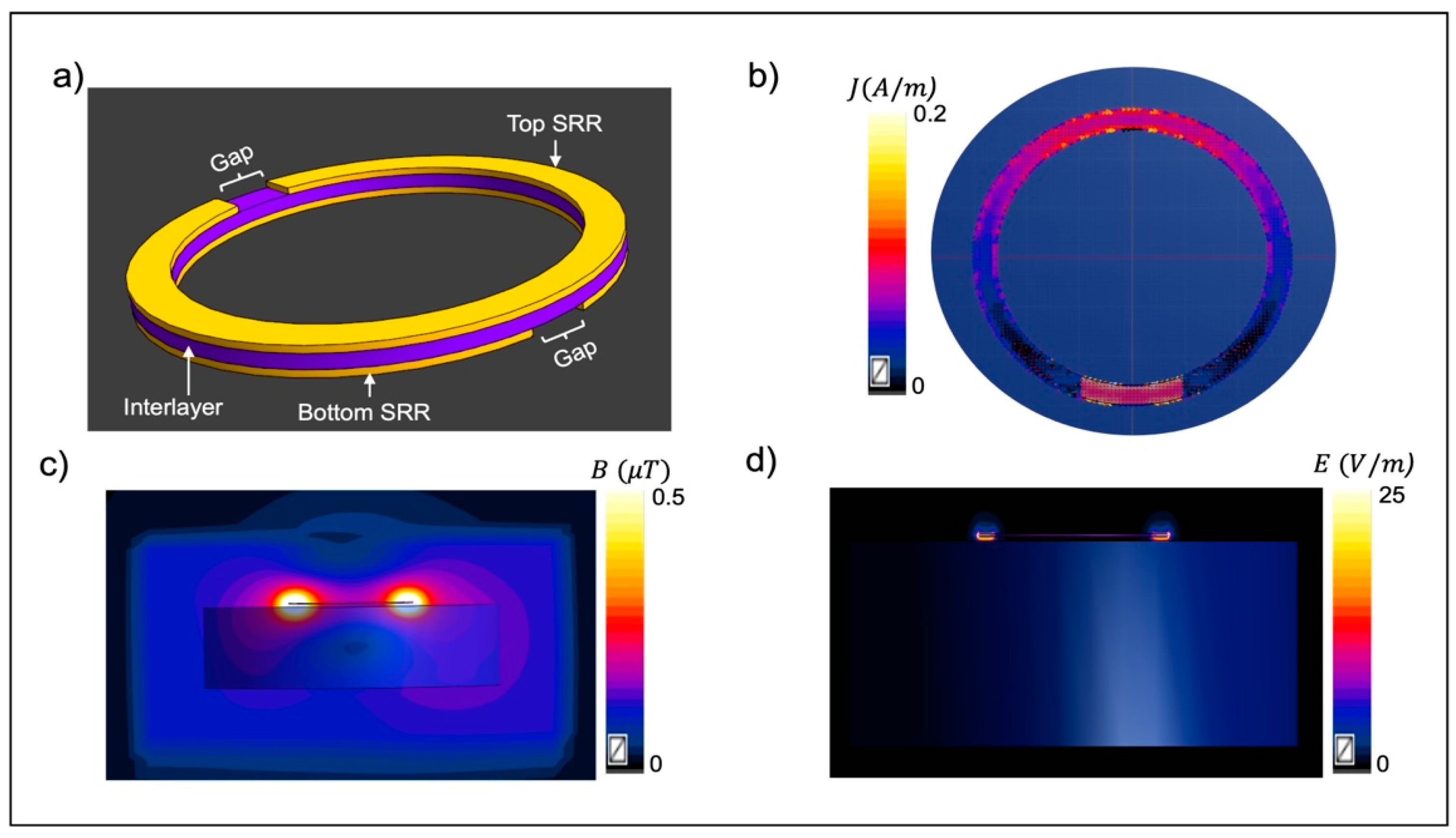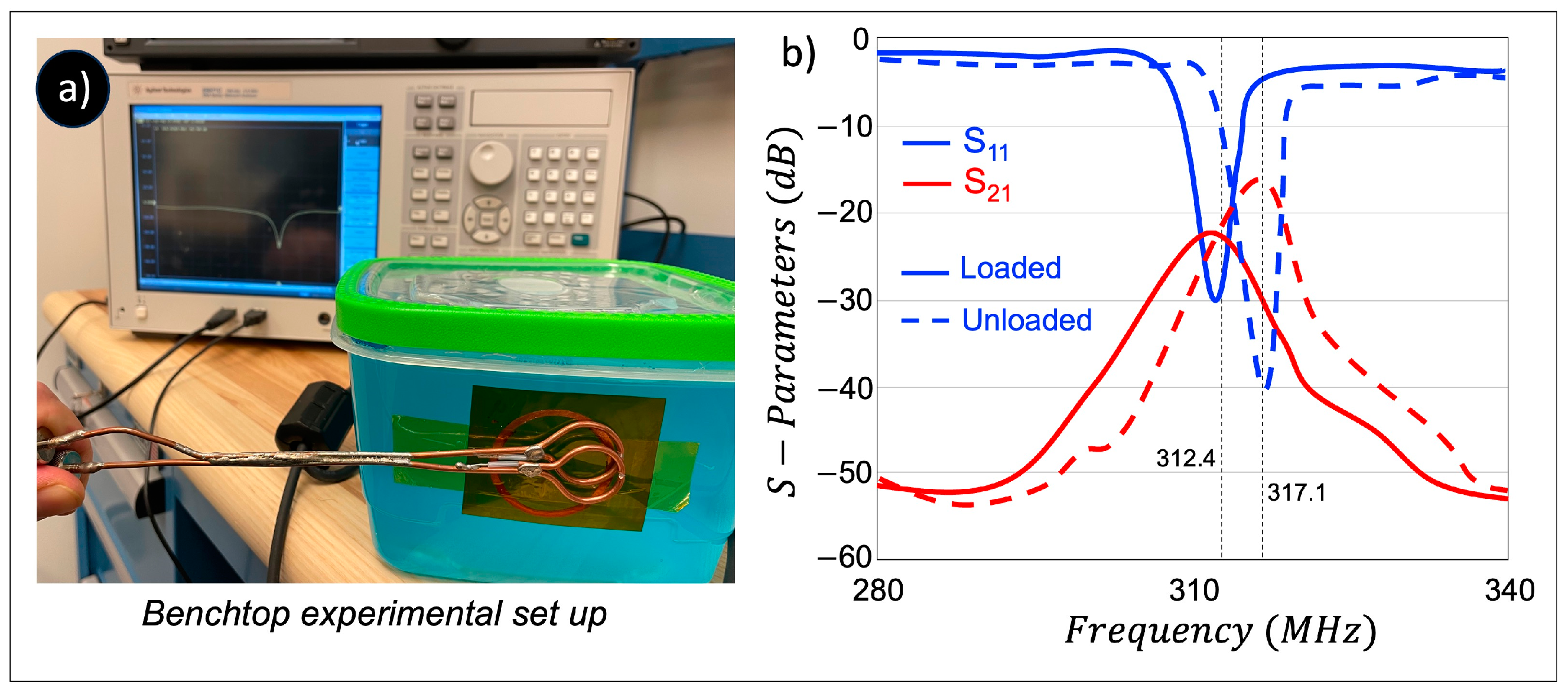Radiofrequency Enhancer to Recover Signal Dropouts in 7 Tesla Diffusion MRI
Abstract
:1. Introduction
2. Materials and Methods
2.1. Theoretical Background
2.2. RF Enhancer
2.3. MRI Experiments
3. Results
4. Discussion
5. Conclusions
Supplementary Materials
Author Contributions
Funding
Institutional Review Board Statement
Informed Consent Statement
Data Availability Statement
Conflicts of Interest
References
- Callaghan, P.T. 45 Physics of Diffusion. In Diffusion MRI: Theory, Methods, and Applications; Jones, P.D.K., Ed.; Oxford University Press: Oxford, UK, 2010. [Google Scholar]
- Mueller, B.A.; Lim, K.O.; Hemmy, L.; Camchong, J. Diffusion MRI and its Role in Neuropsychology. Neuropsychol. Rev. 2015, 25, 250–271. [Google Scholar] [CrossRef]
- Aboitiz, F.; Scheibel, A.B.; Fisher, R.S.; Zaidel, E. Fiber composition of the human corpus callosum. Brain Res. 1992, 598, 143–153. [Google Scholar] [CrossRef]
- Coelho, S.; Pozo, J.M.; Jespersen, S.N.; Jones, D.K.; Frangi, A.F. Resolving degeneracy in diffusion MRI biophysical model parameter estimation using double diffusion encoding. Magn. Reson. Med. 2019, 82, 395–410. [Google Scholar] [CrossRef]
- Lehéricy, S.; Ducros, M.; Van De Moortele, P.-F.; Francois, C.; Thivard, L.; Poupon, C.; Swindale, N.; Ugurbil, K.; Kim, D.-S. Diffusion tensor fiber tracking shows distinct corticostriatal circuits in humans. Ann. Neurol. 2004, 55, 522–529. [Google Scholar] [CrossRef]
- Shao, X.; Ma, S.J.; Casey, M.; D’Orazio, L.; Ringman, J.M.; Wang, D.J.J. Mapping water exchange across the blood–brain barrier using 3D diffusion-prepared arterial spin labeled perfusion MRI. Magn. Reson. Med. 2019, 81, 3065–3079. [Google Scholar] [CrossRef]
- Uğurbil, K.; Xu, J.; Auerbach, E.J.; Moeller, S.; Vu, A.T.; Duarte-Carvajalino, J.M.; Lenglet, C.; Wu, X.; Schmitter, S.; Van de Moortele, P.F.; et al. Pushing spatial and temporal resolution for functional and diffusion MRI in the Human Connectome Project. NeuroImage 2013, 80, 80–104. [Google Scholar] [CrossRef]
- Gallichan, D. Diffusion MRI of the human brain at ultra-high field (UHF): A review. NeuroImage 2018, 168, 172–180. [Google Scholar] [CrossRef]
- Maruyama, S.; Fukunaga, M.; Fautz, H.-P.; Heidemann, R.; Sadato, N. Comparison of 3T and 7T MRI for the visualization of globus pallidus sub-segments. Sci. Rep. 2019, 9, 18357. [Google Scholar] [CrossRef]
- Sadeghi-Tarakameh, A.; DelaBarre, L.; Lagore, R.L.; Torrado-Carvajal, A.; Wu, X.; Grant, A.; Adriany, G.; Metzger, G.J.; Van de Moortele, P.-F.; Ugurbil, K.; et al. In vivo human head MRI at 10.5T: A radiofrequency safety study and preliminary imaging results. Magn. Reson. Med. 2020, 84, 484–496. [Google Scholar] [CrossRef]
- Verma, G.; Balchandani, P. Ultrahigh field MR Neuroimaging. Top. Magn. Reson. Imaging 2019, 28, 137–144. [Google Scholar] [CrossRef]
- Vu, A.T.; Auerbach, E.; Lenglet, C.; Moeller, S.; Sotiropoulos, S.N.; Jbabdi, S.; Andersson, J.; Yacoub, E.; Ugurbil, K. High resolution whole brain diffusion imaging at 7T for the Human Connectome Project. NeuroImage 2015, 122, 318–331. [Google Scholar] [CrossRef]
- Wu, X.; Auerbach, E.J.; Vu, A.T.; Moeller, S.; Lenglet, C.; Schmitter, S.; Van de Moortele, P.-F.; Yacoub, E.; Uğurbil, K. High-resolution whole-brain diffusion MRI at 7T using radiofrequency parallel transmission. Magn. Reson. Med. 2018, 80, 1857–1870. [Google Scholar] [CrossRef]
- Vaughan, J.T.; Garwood, M.; Collins, C.M.; Liu, W.; DelaBarre, L.; Adriany, G.; Andersen, P.; Merkle, H.; Goebel, R.; Smith, M.B.; et al. 7T vs. 4T: RF power, homogeneity, and signal-to-noise comparison in head images. Magn. Reson. Med. 2001, 46, 24–30. [Google Scholar] [CrossRef]
- Ladd, M.E.; Bachert, P.; Meyerspeer, M.; Moser, E.; Nagel, A.M.; Norris, D.G.; Schmitter, S.; Speck, O.; Straub, S.; Zaiss, M. Pros and cons of ultra-high-field MRI/MRS for human application. Prog. Nucl. Magn. Reson. Spectrosc. 2018, 109, 1–50. [Google Scholar] [CrossRef]
- Van de Moortele, P.F.; Akgun, C.; Adriany, G.; Moeller, S.; Ritter, J.; Collins, C.M.; Smith, M.B.; Vaughan, J.T.; Uğurbil, K. B1 destructive interferences and spatial phase patterns at 7 T with a head transceiver array coil. Magn. Reson. Med. 2005, 54, 1503–1518. [Google Scholar] [CrossRef]
- Katscher, U.; Börnert, P. Parallel RF transmission in MRI. NMR Biomed. 2006, 19, 8. [Google Scholar] [CrossRef] [PubMed]
- Balchandani, P.; Khalighi, M.M.; Glover, G.; Pauly, J.; Spielman, D. Self-refocused adiabatic pulse for spin echo imaging at 7 T. Magn. Reson. Med. 2012, 67, 1077–1085. [Google Scholar] [CrossRef]
- Vorobyev, V.; Shchelokova, A.; Zivkovic, I.; Slobozhanyuk, A.; Baena, J.D.; del Risco, J.P.; Abdeddaim, R.; Webb, A.; Glybovski, S. An artificial dielectric slab for ultra high-field MRI: Proof of concept. J. Magn. Reson. 2020, 320, 106835. [Google Scholar] [CrossRef]
- Webb, A.G. Dielectric materials in magnetic resonance. Concepts Magn. Reson. Part A 2011, 38, 148–184. [Google Scholar] [CrossRef]
- Yang QX, M.W.; Wang, J.; Smith, M.B.; Lei, H.; Zhang, X.; Ugurbil, K.; Chen, W. Manipulation of image intensity distribution at 7.0 T: Passive RF shimming and focusing with dielectric materials. J. Magn. Reson. Imaging 2006, 24, 197–202. [Google Scholar] [CrossRef]
- Haines, K.; Smith, N.B.; Webb, A.G. New high dielectric constant materials for tailoring the B1+ distribution at high magnetic fields. J. Magn. Reson. 2010, 203, 323–327. [Google Scholar] [CrossRef]
- Schmidt, R.; Slobozhanyuk, A.; Belov, P.; Webb, A. Flexible and compact hybrid metasurfaces for enhanced ultra high field in vivo magnetic resonance imaging. Sci. Rep. 2017, 7, 1678. [Google Scholar] [CrossRef]
- Koloskov, V.; Brink, W.M.; Webb, A.G.; Shchelokova, A. Flexible metasurface for improving brain imaging at 7T. Magn. Reson. Med. 2024, 92, 869–890. [Google Scholar] [CrossRef]
- Motovilova, E.; Huang, S.Y. Hilbert Curve-Based Metasurface to Enhance Sensitivity of Radio Frequency Coils for 7-T MRI. IEEE Trans. Microw. Theory Tech. 2019, 67, 615–625. [Google Scholar] [CrossRef]
- Gomez, T.S.V.; Dubois, M.; Rustomji, K.; Georget, E.; Antonakakis, T.; Vignaud, A.; Rapacchi, S.; Girard, O.M.; Kober, F.; Enoch, S.; et al. Hilbert fractal inspired dipoles for passive RF shimming in ultra-high field MRI. Photonics Nanostructures-Fundam. Appl. 2022, 48, 100988. [Google Scholar] [CrossRef]
- Stoja, E.; Konstandin, S.; Philipp, D.; Wilke, R.N.; Betancourt, D.; Bertuch, T.; Jenne, J.; Umathum, R.; Günther, M. Improving magnetic resonance imaging with smart and thin metasurfaces. Sci. Rep. 2021, 11, 16179. [Google Scholar] [CrossRef]
- Alipour, A.; Seifert, A.C.; Delman, B.N.; Hof, P.R.; Fayad, Z.A.; Balchandani, P. Enhancing the brain MRI at ultra-high field systems using a meta-array structure. Med. Phys. 2023, 50, 7606–7618. [Google Scholar] [CrossRef]
- Alipour, A.; Seifert, A.C.; Delman, B.; Shrivastava, R.; Adriany, G.; Fayad, Z.A.; Balchandani, P. Enhanced Ultra-High Field Brain MRI Using a Wireless Radiofrequency Sheet. Int. Soc. Magn. Reson. Med. 2021, 29, 0129. [Google Scholar]
- Alipour, A.; Seifert, A.C.; Delman, B.N.; Robson, P.M.; Shrivastava, R.; Hof, P.R.; Adriany, G.; Fayad, Z.A.; Balchandani, P. Improvement of magnetic resonance imaging using a wireless radiofrequency resonator array. Sci. Rep. 2021, 11, 23034. [Google Scholar] [CrossRef]
- Alipour, A.; Gokyar, S.; Algin, O.; Atalar, E.; Demir, H.V. An inductively coupled ultra-thin, flexible, and passive RF resonator for MRI marking and guiding purposes: Clinical feasibility. Magn. Reson. Med. 2018, 80, 361–370. [Google Scholar] [CrossRef]
- Gokyar, S.; Alipour, A.; Unal, E.; Atalar, E.; Demir, H.V. Magnetic Resonance Imaging Assisted by Wireless Passive Implantable Fiducial e-Markers. IEEE Access 2017, 5, 19693–19702. [Google Scholar] [CrossRef]
- Syms, R.R.A.; Young, I.R.; Ahmad, M.M.; Rea, M. Magnetic resonance imaging using linear magneto-inductive waveguides. J. Appl. Phys. 2012, 112, 114911. [Google Scholar] [CrossRef]
- Alipour, A.; Unal, E.; Gokyar, S.; Demir, H.V. Development of a distance-independent wireless passive RF resonator sensor and a new telemetric measurement technique for wireless strain monitoring. Sens. Actuators A Phys. 2017, 255, 87–93. [Google Scholar] [CrossRef]
- Gokyar, S.; Alipour, A.; Unal, E.; Atalar, E.; Demir, H.V. Wireless deep-subwavelength metamaterial enabling sub-mm resolution magnetic resonance imaging. Sens. Actuators A Phys. 2018, 274, 211–219. [Google Scholar] [CrossRef]
- Freire, M.J.; Lopez, M.A.; Meise, F.; Algarin, J.M.; Jakob, P.M.; Bock, M.; Marques, R. A Broadside-Split-Ring Resonator-Based Coil for MRI at 7 T. IEEE Trans. Med. Imaging 2013, 32, 1081–1084. [Google Scholar] [CrossRef]
- Marques, R.; Mesa, F.; Martel, J.; Medina, F. Comparative analysis of edge- and broadside- coupled split ring resonators for metamaterial design—Theory and experiments. IEEE Trans. Antennas Propag. 2003, 51, 2572–2581. [Google Scholar] [CrossRef]
- Dia, K.K.H.; Hajiaghajani, A.; Escobar, A.R.; Dautta, M.; Tseng, P. Broadside-Coupled Split Ring Resonators as a Model Construct for Passive Wireless Sensing. Adv. Sens. Res. 2023, 2, 2300006. [Google Scholar] [CrossRef]
- Eryaman, Y.; Akin, B.; Atalar, E. Reduction of implant RF heating through modification of transmit coil electric field. Magn. Reson. Med. 2011, 65, 1305–1313. [Google Scholar] [CrossRef]
- Celik, H.; Atalar, E. Reverse polarized inductive coupling to transmit and receive radiofrequency coil arrays. Magn. Reson. Med. 2012, 67, 446–456. [Google Scholar] [CrossRef]
- Wang, S.; Murphy-Boesch, J.; Merkle, H.; Koretsky, A.P.; Duyn, J.H. B1 Homogenization in MRI by Multilayer Coupled Coils. IEEE Trans. Med. Imaging 2009, 28, 551–554. [Google Scholar] [CrossRef]
- Tournier, J.D.; Smith, R.; Raffelt, D.; Tabbara, R.; Dhollander, T.; Pietsch, M.; Christiaens, D.; Jeurissen, B.; Yeh, C.-H.; Connelly, A. MRtrix3: A fast, flexible and open software framework for medical image processing and visualisation. NeuroImage 2019, 202, 116137. [Google Scholar] [CrossRef]
- Wasserthal, J.; Neher, P.; Maier-Hein, K.H. TractSeg—Fast and accurate white matter tract segmentation. NeuroImage 2018, 183, 239–253. [Google Scholar] [CrossRef]
- ASTM F2482-11a; Measurement of Radio Frequency Induced Heating on or Near Passive Implants During Magnetic Resonance Imaging. ASTM: West Conshohocken, PA, USA, 2011.
- FDA. Safety Guidelines for Magnetic Resonance Imaging Equipment in Clinical Use; Medicine and Healthcare Products Regulatory Agency: London, UK, 2014. [Google Scholar]
- Moniruzzaman, M.; Islam, M.T.; Islam, M.R.; Misran, N.; Samsuzzaman, M. Coupled ring split ring resonator (CR-SRR) based epsilon negative metamaterial for multiband wireless communications with high effective medium ratio. Results Phys. 2020, 18, 103248. [Google Scholar] [CrossRef]









Disclaimer/Publisher’s Note: The statements, opinions and data contained in all publications are solely those of the individual author(s) and contributor(s) and not of MDPI and/or the editor(s). MDPI and/or the editor(s) disclaim responsibility for any injury to people or property resulting from any ideas, methods, instructions or products referred to in the content. |
© 2024 by the authors. Licensee MDPI, Basel, Switzerland. This article is an open access article distributed under the terms and conditions of the Creative Commons Attribution (CC BY) license (https://creativecommons.org/licenses/by/4.0/).
Share and Cite
Subramaniam, V.; Frankini, A.; Al Qadi, A.; Herb, M.T.; Verma, G.; Delman, B.N.; Balchandani, P.; Alipour, A. Radiofrequency Enhancer to Recover Signal Dropouts in 7 Tesla Diffusion MRI. Sensors 2024, 24, 6981. https://doi.org/10.3390/s24216981
Subramaniam V, Frankini A, Al Qadi A, Herb MT, Verma G, Delman BN, Balchandani P, Alipour A. Radiofrequency Enhancer to Recover Signal Dropouts in 7 Tesla Diffusion MRI. Sensors. 2024; 24(21):6981. https://doi.org/10.3390/s24216981
Chicago/Turabian StyleSubramaniam, Varun, Andrew Frankini, Ameen Al Qadi, Mackenzie T. Herb, Gaurav Verma, Bradley N. Delman, Priti Balchandani, and Akbar Alipour. 2024. "Radiofrequency Enhancer to Recover Signal Dropouts in 7 Tesla Diffusion MRI" Sensors 24, no. 21: 6981. https://doi.org/10.3390/s24216981
APA StyleSubramaniam, V., Frankini, A., Al Qadi, A., Herb, M. T., Verma, G., Delman, B. N., Balchandani, P., & Alipour, A. (2024). Radiofrequency Enhancer to Recover Signal Dropouts in 7 Tesla Diffusion MRI. Sensors, 24(21), 6981. https://doi.org/10.3390/s24216981




